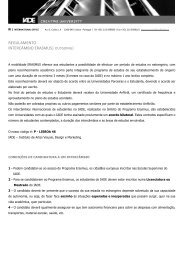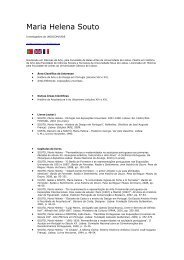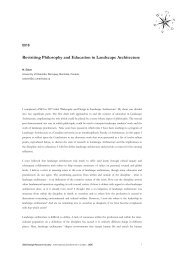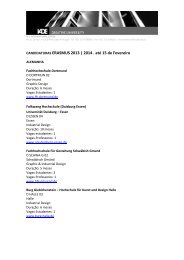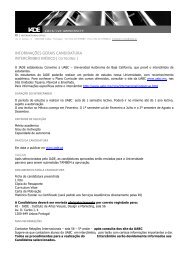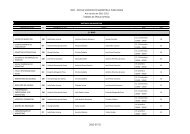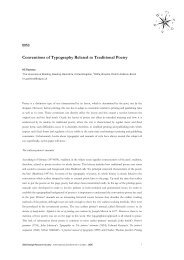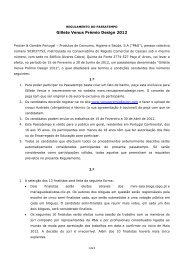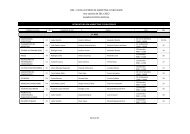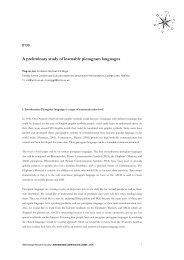0186 Graphic Design and Motion Graphics - IADE
0186 Graphic Design and Motion Graphics - IADE
0186 Graphic Design and Motion Graphics - IADE
Create successful ePaper yourself
Turn your PDF publications into a flip-book with our unique Google optimized e-Paper software.
<strong>0186</strong><br />
<strong>Graphic</strong> <strong>Design</strong> <strong>and</strong> <strong>Motion</strong> <strong>Graphic</strong>s<br />
C Vincent, A Cole, Z Schincariol<br />
Universidade Presbiteriana Mackenzie - FAU-DI, São Paulo, SP, Brazil | zuleicaschincariol@hotmail.com<br />
Introduction<br />
These are the first reflections on a recent experiment in teaching Editorial <strong>Graphic</strong> <strong>Design</strong> <strong>and</strong> <strong>Motion</strong> <strong>Design</strong><br />
in an interdisciplinary work focusing on the same target: typography. It begins with training graphic design<br />
skills, with an emphasis on the expressive potential of textual elements. Then, the same subject is re-compiled<br />
for display on video. When one takes into account the specifics of each media, the expectations converge in<br />
terms of provoking a broader view of typography as a design element. This is a work in progress that,<br />
although at the beginning stage, opens up new ground in Communication <strong>Design</strong> Education.<br />
<strong>Graphic</strong>s Trial: <strong>Design</strong> principles <strong>and</strong> processes.<br />
An exercise is proposed in which the students produce a <strong>Graphic</strong> trial, planned as an Editorial <strong>Graphic</strong><br />
Product – a book, which starts with interpreting a given theme that all the students are familiar with. The<br />
textual content, which can be freely chosen, is interpreted with typography only <strong>and</strong> designed to convey spatial<br />
<strong>and</strong> graphic perceptions like scale, tone, texture, transparency, line-surface, form-counter form, static-dynamics. This series<br />
of typographic compositions is made with the maximum degree of contrast: black printing on white surface.<br />
Then, another significance generator is introduced: chromatics, which is perceived <strong>and</strong> experimented with on a<br />
finished composition. Two studies are thus made in color. The series of studies is completed by designing a<br />
typographic illustration, based on a given image that has already been printed <strong>and</strong> is linked to the proposed<br />
theme.<br />
The editorial organization <strong>and</strong> the sequential rhythm follow the conceptual definitions of each project, as well<br />
as the cover design, front page <strong>and</strong> colophon. The whole design process considers the book as being an<br />
integral object, encouraging readers to approach it <strong>and</strong> to h<strong>and</strong>le it like an important sensorial, or even sensual,<br />
feature of printed medium, as experienced by Munari in his “Unreadable Book” (Munari, 1981, p. 220-227),<br />
where the emphasis is on the visual <strong>and</strong> tactile possibilities of the means of production: supports, surface<br />
qualities, cuts, etc.<br />
2006 <strong>Design</strong> Research Society . International Conference in Lisbon . <strong>IADE</strong> 1
The main aim is to sharpen the perception of the potential of typography in Visual Communication, beyond<br />
the verbal <strong>and</strong> pictorial contents it conveys. When seen as a graphic registry, the written language takes form<br />
both visually <strong>and</strong> spatially. As Wolfgang Weingart says, it is important to stress that typography, here, has a<br />
broader meaning which is beyond what “can be set <strong>and</strong> printed” (Weingart, 1999, p.222). It is not restrained to<br />
principles of universality, rationality, elegance, economy, precision <strong>and</strong> order. H<strong>and</strong>writing is also treated as<br />
typography in which there is the presence of strokes when forming the seemingly illegible characters or<br />
solutions, as long as they are consciously planned.<br />
At the beginning of the design process a space is opened up to discuss visual manifestations that emphasize, as<br />
they proceed, the typographical experimentation <strong>and</strong> expression, which are considered as ideas, attitudes,<br />
contexts <strong>and</strong> particularities. For instance, the recognized vigor of the modernist vanguards (Spencer, 1969),<br />
the “verbivocovisual i ” of the concrete poets (B<strong>and</strong>eira & Barros, 2002), the “graphic improvisations” of<br />
Aloisio Magalhães at the ´Grafico Amador’ workshops (Leite, 2003), the graphic field used as a stage for<br />
performing the typographic theatrical pieces of Robert Massin (“Robert Massin, action on the page”, 2003), all<br />
contribute. All of them are historic references that stimulate research on contemporary production, as well as<br />
help to put it in its proper context. One can see that, under strict principles <strong>and</strong> greatly diminished emphasis,<br />
experimentation <strong>and</strong> expression are not missing, even among authors who aim towards clarity <strong>and</strong> objectivity,<br />
<strong>and</strong> they are always linked to the balance between form <strong>and</strong> function. ii<br />
Thus, the students have the autonomy to decide on their own routes <strong>and</strong> to define the choice criteria in order<br />
to take their experiments in a certain direction. Having selected <strong>and</strong> comprehended the text, defined the<br />
conception <strong>and</strong> made a first general plan, it is expected that they be involved in a permanent quest, constantly<br />
entwining the relationships between form <strong>and</strong> character that characterize the interactions between<br />
typographical elements with the page, the construction of meanings <strong>and</strong> the production techniques.<br />
São Paulo was one of the general themes covered. The individual choices should be texts that reflect aspects<br />
of the students´ personal life, so that the city may be typographically depicted from different viewpoints.<br />
Three different solutions are presented in figures 1, 2 <strong>and</strong> 3.<br />
Fig. 1. In the work Novelinha de Metro – Camila Christini Tomás – the graphic trial is made upon variations on the Helvetica<br />
typeface, which is a strong visual reference that interferes in the dialogue between two passengers.<br />
2006 <strong>Design</strong> Research Society . International Conference in Lisbon . <strong>IADE</strong> 2
Fig. 2. Augusta – Artur Tillieri – expresses urban decay, the excess of information <strong>and</strong> the profusion <strong>and</strong> contrast of forms<br />
found on a typical metropolitan street. The video graphic work Sujo was made after the first of those compositions.<br />
Fig. 3. Alma de Robô – César de Souza – was made after a broader graphic composition<br />
shown through a series of pans <strong>and</strong> zooms.<br />
The interchange between graphic trials <strong>and</strong> video graphics<br />
Producing a still, immobile image that is generated from the expressive possibilities of typography presents the<br />
challenge of condensing the meanings of what it intends to communicate but, on the other h<strong>and</strong>, helps to<br />
bring about the composition. Researchers on the art creation process (Wollheim, 2002, Salles 1998)<br />
underst<strong>and</strong> that the artist is an agent, spectator <strong>and</strong> witness to the work of art being formed through the<br />
interchange between feeling, thought <strong>and</strong> action. Similarly, the designer is also an agent <strong>and</strong> a spectator of his<br />
own creative process. Thus, he has in his favor whatever time it takes to bring the image to fruition; he is able<br />
to investigate each detail, deviate from the path, weave in other considerations, experiment with new<br />
configurations, make simultaneous comparisons between the images <strong>and</strong> wait for the meanings to emerge out<br />
of the interchange between the spectator <strong>and</strong> the image being configured.<br />
When producing a moving image, the challenge is shifted. It is no longer necessary to condense the meanings<br />
into a single image.<br />
The fixed image, in itself, brings with it elements that gain mobility in audiovisual language, which helps in the<br />
task of building meanings but makes it more complicated to maintain, throughout the moving process, all the<br />
composing relationships, including the audio one which is also part of this language. Arnheim (1994) defines<br />
movement as an organized sequence in which events follow one another in such a way as to create a<br />
meaningful order, in which each detail that is added not only fulfills the whole but also modifies all that has<br />
been previously shown.<br />
2006 <strong>Design</strong> Research Society . International Conference in Lisbon . <strong>IADE</strong> 3
In audiovisual language, a series of elements compete with each other <strong>and</strong> join together to create meanings<br />
<strong>and</strong>, for each choice, an expressive result is shown. The “framing” made possible by a fixed image, which is<br />
the starting point for developing the work, can gain mobility by being moved from a “close-up” to a “wide<br />
frame” which spreads out the spectator’s view, <strong>and</strong> vice versa. It can also acquire other configurations by<br />
adding or subtracting elements, by shifting objects around. “Camera movement” is another important element<br />
in audiovisual language. When we simulate panoramics, travelings, dollyings or zoomings, we are creating<br />
emphasis by directing the eye of the spectator, altering the scale of the elements, imprinting spatial movement<br />
<strong>and</strong> attributing points of view to the spectators’ perceptions.<br />
It is important for us to make a distinction between cinematographic images <strong>and</strong> video graphics. The former<br />
two depend on a certain contiguity with the object it represents. A photograph, or a video take of an empty<br />
chair, depends on the object being there are it maintains a link with its referent object (Barthes, 1984;<br />
Benjamin, 1985; Dubois, 1999). In video graphic pieces, the objects being depicted are lines, textures <strong>and</strong><br />
colors. In fact, there are no objects represented; there is the object itself, the types that take on shapes,<br />
densities, colors <strong>and</strong> movement, which are their own, even though they may simulate shapes of objects. In this<br />
way, we find ourselves immersed in an important universe of design – the typography <strong>and</strong> video graphics.<br />
In order to carry out the work proposed, one out of the 11 typographical compositions done for the graphic<br />
trial needs to be chosen.<br />
First, we consider the graphic <strong>and</strong> expressive qualities of the image, the eloquence <strong>and</strong> coherence of the text<br />
<strong>and</strong> image composition, its originality <strong>and</strong> identity. The second criteria is the result of a limit set by current<br />
technology. The definitions of video graphic images are still made up of lines <strong>and</strong> dots or, in the case of digital<br />
imaging, in pixels, which generate a more textured image, rendering subtleties of color, tone <strong>and</strong> scale of the<br />
printed image impossible. Therefore, it becomes necessary to ensure that the image is suited to the video<br />
graphic support, which requires that the elements of the composition show enough graphic to guarantee a<br />
clear image, since one runs the risk of it becoming illegible or ‘pixelized’ when using tiny elements or very fine<br />
lines<br />
After having made these initial considerations, the potential for transforming the image through movement<br />
<strong>and</strong> the potential for building meanings are analyzed. These transformations can present emphasis both in<br />
space <strong>and</strong> time (Arnheim, 1994). The work entitled ‘Sujo’ (fig.8), for example, shows transformations that are<br />
developed mainly in terms of time <strong>and</strong> are presented in space in a subtle <strong>and</strong> relatively stable manner. In<br />
contrast with this example, we have the work ‘Alma de Robo’ (fig.6) in which the elements slide at speed from<br />
left to right, showing a flagrant shifting in space. This is also seen in the work, ‘Estacas’ (fig 4), in which the text<br />
is moved from the foreground to the background, which generates huge alterations in the sequence of images<br />
<strong>and</strong> in a series of superimpositions that gyrate creating ‘moirés’. The meaning can then be contained in the<br />
fixed image or can present any new contents through the movement.<br />
There are works that already present, in themselves, suggestions of movement, <strong>and</strong> this suggestion may or may<br />
not be appropriate. Not making use of this suggestion of movement provided by the image may be either a<br />
2006 <strong>Design</strong> Research Society . International Conference in Lisbon . <strong>IADE</strong> 4
productive challenge or result in nonsense. However, most of the time we repeatedly see the movement<br />
suggested by the image itself being made use of, as can be seen in the works: Ventinho da Paulista (fig.7), Saudosa<br />
Maloca (fig.5), among others.<br />
Fig. 4. Estaca – Hugo Takahashi<br />
.<br />
Fig. 5. Saudosa Maloca – Alfio Presutti.<br />
Fig.6. Alma de Robô – César de Souza.<br />
2006 <strong>Design</strong> Research Society . International Conference in Lisbon . <strong>IADE</strong> 5
Fig. 7.Ventinho na Paulista – Osmair Krespi<br />
Fig. 8. Sujo – Artur Tillieri.<br />
Conclusion<br />
Even when movement is suggested by the original image, there is a process of subjacent creation that is carried<br />
out at each action. We know that the creative process is based on perception (Ostrower, 1990; Gombrich,<br />
1986) <strong>and</strong> is carried out by means of a complexity of actions involving ideas, experimentation, research,<br />
rejecting, rescuing, reflection, revision, decisions, choices <strong>and</strong> certainties (Salles, 1998). Therefore, as in all<br />
creative processes, the role of experimentation is shown to be an important research instrument when making<br />
video graphic pieces, since it is experimentation that gives form to the images that establish a dialogue with the<br />
designer who will evaluate their visual quality, their expressiveness <strong>and</strong> meaning.<br />
We also know that the creative process is a continuous flow. In this respect, the student brings<br />
together all the experience he has accumulated in manipulating the typography he has previously carried out<br />
<strong>and</strong> uses the knowledge he has acquired during the course, choosing reference visuals, building his own<br />
2006 <strong>Design</strong> Research Society . International Conference in Lisbon . <strong>IADE</strong> 6
identity in the way in which he expresses himself, creating meanings <strong>and</strong> communicating his built up<br />
knowledge, through the production of typographic <strong>and</strong> video graphic images, <strong>and</strong> also making use of the<br />
resources of audiovisual language. Thus, we can observe that, in fact, there is development in the<br />
underst<strong>and</strong>ing of typography as an element of design <strong>and</strong> in the sensitivity with which it is used. Even though<br />
this interdisciplinary experiment is just the first move towards approximation, still with a lot of possibilities for<br />
evolving more, we can see that this knowledge is built up through the creative process <strong>and</strong> can contribute to<br />
the perception of typographic design <strong>and</strong> the awareness of the specific means of communication in each<br />
media.<br />
References<br />
Barros, Lenora de; B<strong>and</strong>eira, João. (2002).Grupo Noig<strong>and</strong>res. São Paulo: Cosac & Naif.<br />
Barthes, Rol<strong>and</strong>. (1984) A câmara clara: nota sobre a fotografia. (Júlio Castañon Guimarães, Trans.). Rio de Janeiro.<br />
Nova Fronteira.<br />
Benjamin, Walter. (1985). Pequena história da fotografia. In: Obras escolhidas, magia e técnica, arte e política Vol 1.<br />
Trad. Sérgio Paulo Rouanet. São Paulo: Brasiliense.<br />
Campos, Augusto. (2001). Viva Vaia. Poesia 1949-1979. São Paulo: Ateliê Editorial.<br />
Dubois, Phillipe. (1999). O ato fotográfico. São Paulo: Papirus.<br />
Gombrich, E.H. (1986) Arte e ilusão. São Paulo: Martins Fontes.<br />
Ferlauto, Claudio; Jahn, Heloisa. (2001). O livro da gráfica. São Paulo: Rosari.<br />
Leite, João de Souza. (2003). A herança do olhar: o design de Aloísio Magalhães. Rio de Janeiro: Artviva.<br />
Munari, Bruno. (1981).Das coisas nascem coisas. São Paulo: Martins Fontes.<br />
Ostrower, Fayga. (1990) Acasos e criação artística. Rio de Janeiro: Campus.<br />
Robert Massin: ação na página impressa. (2003, maio/junho, No. 30) Revista Arc <strong>Design</strong>, 62-69.<br />
Salles, Cecília Almeida. (1998). O gesto inacabado: processo de criação artística. São Paulo: FAPESP/Annablume.<br />
Spencer, Herbert. (1969). Pioners of modern typography. Londres: Lund Humphries.<br />
Wollheim, Richard. (2002).A pintura como Arte. (Vera Pereira, Trans.). São Paulo: Cosac&Naify.<br />
Weingart, Wolfgang. (1999). How can one make swiss typography?. In: Bierut, M. et al. (Eds.). Looking closer 3:<br />
classic writings on graphic design. New York: Allworth, pp.219-237.<br />
i Verbal, Vocal <strong>and</strong> Visual, in the original expression coined by Augusto de Campos.<br />
ii Emil Ruder, in the introduction to his Manual de Diseño Tipográfico, confirms the necessity to be “trained in experimental typography”. In this same<br />
book a section opens, with reservations <strong>and</strong> excesses, with the poetics of “Spontaneity <strong>and</strong> chance”. Also, under strict parameters, Will Kunz has<br />
an experimental proposal looking into effective communication of both the “intellectual meaning” <strong>and</strong> the “emotional content” of the<br />
message. See:<br />
Ruder, Emil. Manual de diseño tipográfico. Barcelona: Gustavo Gili, 1982.<br />
Kunz, Willi. Tipografía: macro y microestética. Barcelona: Gustavo Gili, 2003. p.8<br />
2006 <strong>Design</strong> Research Society . International Conference in Lisbon . <strong>IADE</strong> 7





